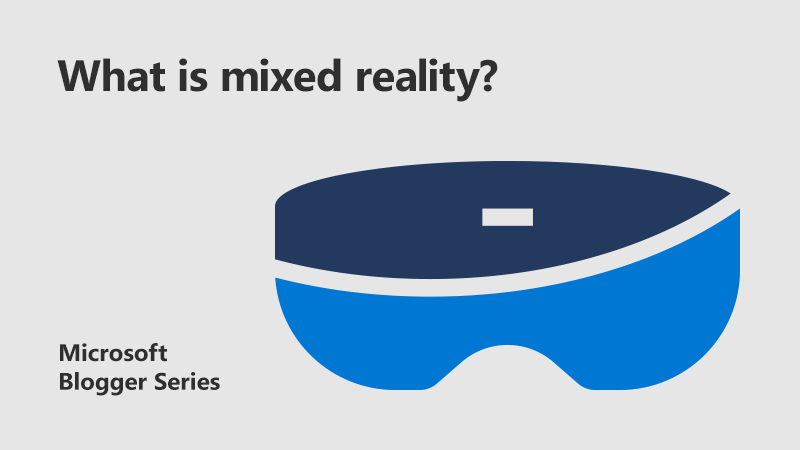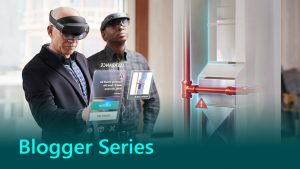
What is mixed reality and is it right for your business?
Mixed reality is, for many of us, considered the third-wave of computing. Having enabled productivity with desktop computing, mobile devices then allowed people to take that capability and intelligence with them on a 2D screen.
Today, whilst information is everywhere, it’s often not in the hands of first-line workers when and where they need it. I’m talking about people who are working in front of customers and with products day to day.
Mixed reality allows us to blend the digital and the physical worlds, infusing the environment around them with relevant information, and empowering you to achieve more.
How do businesses use mixed reality?
Organisations across just about every industry have found valuable commercial applications for mixed reality. The applications with the clearest ROI can be grouped into a few areas:
- Remote assistance
- Training and task guidance
- Spatial planning and analytics
- Collaborative visualisation
Microsoft has responded to the clear customer demand for turnkey solutions in these areas with a range of mixed reality products under the Dynamics 365 brand.
For instance, one global energy provider uses Dynamics 365 Remote Assist to connect technicians with remote experts across the world. Together, they can troubleshoot problems in real-time to keep their operations online and incident-free.
Or take the example of an American truck manufacturer that improves its employee on-boarding and assembly line processes using Dynamics 365 Guides. First-line workers that used the technology were vocal about how mixed reality-based Guides made them feel confident and empowered to be effective in their job from day one.
Mixed reality also enables sales professionals at organisations to deliver a better customer experience, thanks to Product Visualise. It also allows far more efficient planning of spaces through Dynamics 365 Layout.
What these scenarios all have in common, is the need to bring digital information into the physical context of employees’ work.
How can mixed reality help your employees?
A good employee experience is essential for any successful business. Engaged and empowered employees are more productive, perform better, and stay with businesses longer. A core part of this is giving them the skills they need to reach their full potential.
Take the manufacturing industry, where there’s a huge gap between the number of available skilled workers and the number of jobs in many countries. In the US, 25% of workers will be eligible for retirement in the next two years. So, whilst 3.5 million jobs will be created over the next decade, only half of those jobs will get filled due to a shortage of skills.
This provides the ideal opportunity to harness mixed reality, combined with Dynamics 365 Guides, to empower your employees with the tools, expertise, and skills they need to be professionally successful.
Just imagine a set of guided instructions following you around as you perform your new job, enabling you to learn as you go, with both hands free, without distracting your new colleagues. With mixed reality, it’s possible to digitally overlay information over real-world objects, making it even easier for your team to understand a complex procedure and get it right first and every time. This shift from static 2D images, documents and classroom training into interactive, on-the-job learning means that knowledge is applied immediately and is retained.
Not only is the training and activity more effective, but you also generate valuable data that can be used to improve that training experience for the rest of your team.
How else will it transform my business?
During this year’s Future Decoded event, I had the opportunity to discuss mixed reality with Microsoft partner DXC. The firm explained how important it was to understand the current way of working and training.
This is a world of classroom-based learning, PDF instructions, and paper manuals. And it’s necessary for companies like DXC to help businesses translate these traditional methods into mixed reality – an engaging combination of text, video, images, animations, and 3D assets.
Dynamics 365 Guides must also be intuitive and user-friendly, in order to engage your employees. Holograms must be carefully selected and placed. Custom media is also sometimes necessary.
How do you follow-up your first successful project?
At the start of the journey, you’ll want to start small. A proof of concept focused on one specific use case, such as remote assistance, or a training scenario, for example. This lets you gain familiarity with the technology, how to use it, how to maximise its value. With your eye undoubtedly on the business impact, this is the ideal moment to establish the ROI.
Once this project has proved successful, you can begin to move on to broader mixed reality projects. This is when you can begin expanding the scope by adding additional use cases or scenarios. If you’re feeling bold, you may even incorporate other technologies like IoT and analytics.
With a full production rollout, it’s time to consider security and device management, too. But once you’re up and running, you can focus on the really exciting part: how to integrate the technology across your organisation.
Find out more
Transform your field service with IoT, AI and mixed reality
About the author
 Matt is currently a Senior Product Manager at Microsoft aligned to Dynamics 365, focusing on Customer Engagement. He is fascinated by the way tech can improve marketing, sales and customer service, as well as how tech providers market and sell these solutions. Prior to his experience at Microsoft he worked at a number of tech businesses, including one of the top analyst firms Gartner, honing his client development and relationship management skills. He is currently completing an MBA at Imperial College.
Matt is currently a Senior Product Manager at Microsoft aligned to Dynamics 365, focusing on Customer Engagement. He is fascinated by the way tech can improve marketing, sales and customer service, as well as how tech providers market and sell these solutions. Prior to his experience at Microsoft he worked at a number of tech businesses, including one of the top analyst firms Gartner, honing his client development and relationship management skills. He is currently completing an MBA at Imperial College.




